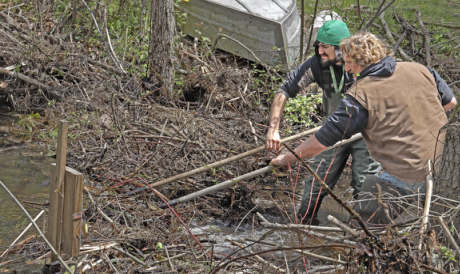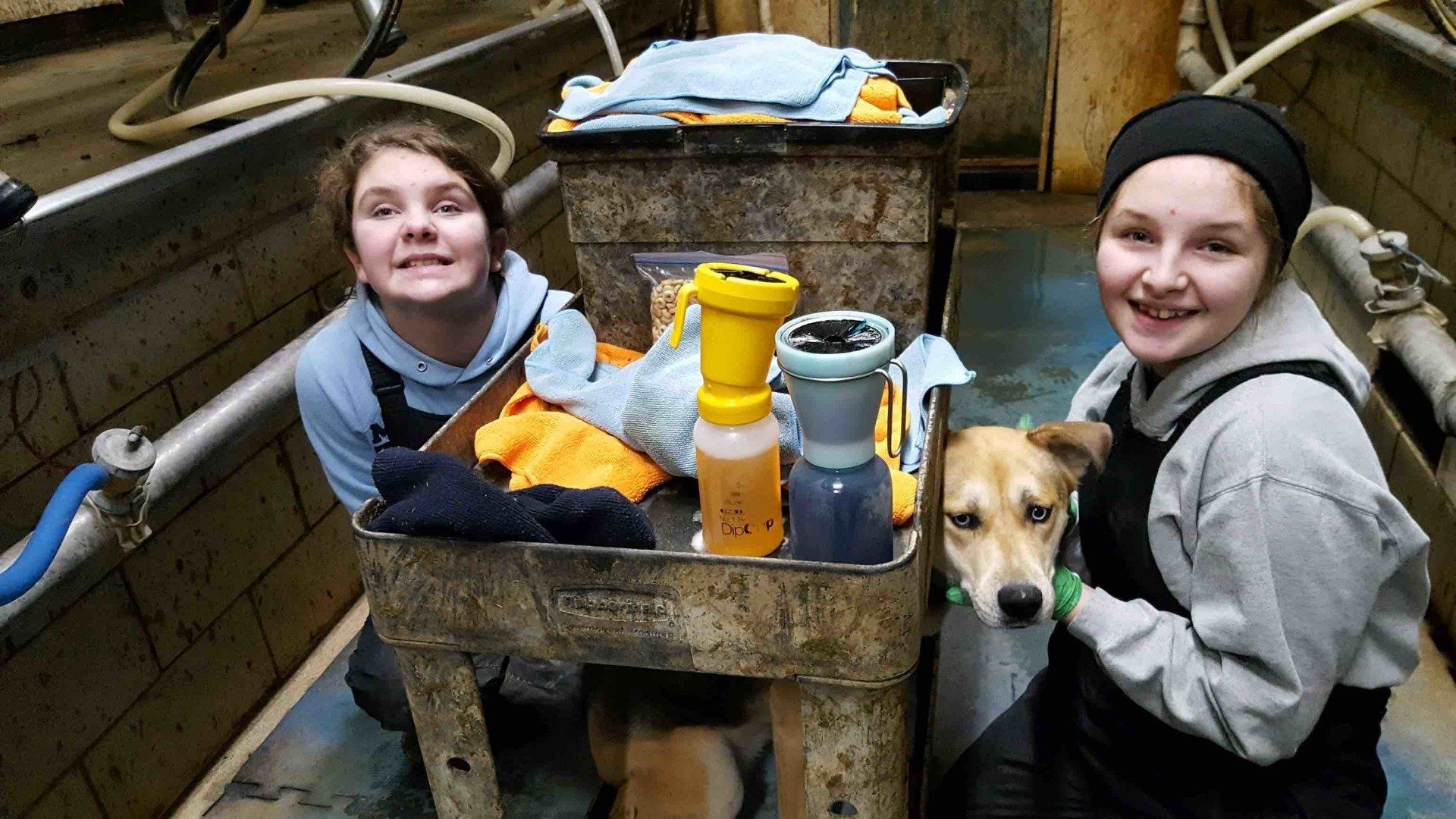Pandemic impact leaves no farmer untouched
Imagine working all day, then watching as almost half that day’s pay has to be washed down the drain.
Michigan dairy farmers don’t have to imagine it.
That’s the catastrophe they face during the economic disaster caused by the COVID-19 pandemic.
Michigan Farm News recently reported that Wisconsin-based Families Dairy USA Cooperative ordered that 40 percent of all milk produced by farmers be dumped until contracts could be renewed or proper packaging for retail sales were available.
That hasn’t happened here on that scale, but farmers are preparing for the possibility.
Some dairy farmers may be left with no other choice but to sell cows.
Dairy farming is an important part of the county’s agricultural profile. Out of Michigan’s 83 counties, Barry ranks seventh for the production of milk from cows, according to the 2017 U.S. Census of Agriculture.
Cattle ranchers are being hard hit, too, by a flooded market and plummeting beef prices.
And, with farmers markets closed, fruit and vegetable farmers are being left with few options for getting their products to consumers. Some are leaving their crops in the field rather than putting additional labor into something they have no hope of selling.
“Crazy is an understatement for what’s going on,” Barry County Board of Commission Chairwoman Heather Wing said.
Wing and her husband own a small family farm at their home in southwestern Barry County.
“As you know, dairy farming in the last five years has not been pleasant,” Wing said. “We’ve lost a lot of neighboring farms due to the issues.
“But this is a crisis that directly impacts us.”
Accountants can work from home. Athletes can stop playing. But cows don’t stop producing milk.
Dairy cows are milked twice a day – whether people are drinking the milk or not.
“Cows are not doing any social distancing; they are still producing the same amount of milk,” Wing said. “Not necessarily in Barry County, but in other places, people are dumping milk.”
Another Barry County farmer said he sees another unpleasant reality when he shops at grocery stores during the stay-home order.
If people are worried about COVID-19, some of them sure aren’t buying health-boosting foods.
“I’ve been appalled that people haven’t been taking more milk out instead of the other 24-packs of drinks,” said Larry Crandall, owner of a family-operated dairy farm in the southernmost part of the county.
Milk has a high level of vitamin D, Crandall said. While it may not offer a cure for COVID-19, it has been found to boost immune systems and help the body fight disease, he said.
“The sometimes-empty supermarket milk coolers reflect supply-chain adaptation challenges, not lack of supply,” Michigan Farm Bureau Livestock and Dairy Specialist Ernie Birchmeier wrote in an April 7 press release. “Experts do not expect retail demand for dairy to make up for lost food service and restaurant demand.”
In a letter to U.S. Secretary of Agriculture Sonny Perdue, leaders in the dairy production industry called for more federal aid to help farmers who are struggling with financial hardships as a result of COVID-19.
The letter was from Dave Buholzer, president of Wisconsin Cheese Makers Association; Brody Stapel, president of Edge Dairy Farmer Cooperative; Tom Crave, president of Dairy Business Association; Dan Smith, President and CEO of Cooperative Network; Joe Bragger, president of Wisconsin Farm Bureau Federation; Jay Heeg, president of Professional Dairy Producers of Wisconsin; and Darin Von Ruden, president of Wisconsin Farmers Union.
“With 80 percent of Americans under order to shelter in their homes, hundreds of thousands of restaurants, schools, and other food service outlets have closed or significantly reduced offerings, which means cheese and butter manufacturers have lost their largest market,” the dairy industry leaders wrote.
Concerned citizens flocking to grocery stores and stocking up on a multitude of different items – including dairy and other perishable items produced by the agricultural industry – have settled down as they have become accustomed to staying at home.
“Dairy manufacturers and processors have also seen their export markets decimated,” their letter noted. “Dairy processors and farmers are working in cooperation and with open lines of communication, but these circumstances, far beyond their control, are beginning to result in fresh farm milk finding no available market for processing.”
In the letter, they asked that the U.S. Department of Agriculture ensure that dairy production is sustained by providing direct relief to these farmers and purchase a substantial number of dairy commodities, specifically, nonfat dry milk, butter, cheddar styles, mozzarella, and other Italian-styles of cheese, both in bulk and in formats intended for use by restaurants and food service vendors.
“We thought we were in good shape going into the summer,” Crandall said. “Nobody expected this virus to come through and create the havoc that it is. I didn’t think people traveled that far and fast. We’ve got to be more careful.”
Crandall’s 1,000-acre farm, which houses a herd of 350 dairy cattle, has been in operation since the late 1800s.
His cows produce an average of 98 gallons of milk a day, which means that his 7,000-gallon storage tank is nearly full by the time the milk truck arrives every second day.
If the worst were to be realized, and Crandall had to begin dumping milk – his farm would lose an estimated 2,800 gallons of product every 48 hours.
“Consumption by consumers is falling apart,” Crandall said. “When people can’t get out of their homes to eat out, it affects us big-time.”
Even when milk is seemingly flying off grocery store shelves across the state, only about 36 percent of the milk produced ends up in a bottle. The rest becomes powder, cheese, butter, and other dairy products.
But with schools and restaurants closed -- or only operating at a tiny fraction of what they used to – dairy farmers are struggling to find places to sell their product.
“Schools, restaurants and universities that were among the main purchasers of milk and milk products were suddenly shuttered, leaving dairy farmers with far more milk than plants are capable of processing for the consumer retail market,” the Michigan Farm Bureau’s Birchmeier said.
In fact, some Michigan dairy producers had to look outside the state for buyers.
For Wing and other dairy farmers across the county, the last five years have been brutal.
They’ve been met with declining demand, and price, for their product while dealing with severe weather that has decimated Michigan fields and farms.
The current poor status of dairy production has become a cruel reality for what many had hoped would be a promising season.
Milk is sold by the hundred weight – or a price for each 100 pounds of milk. Dairy producers like Crandall and Wing were expecting the price of milk to rise this year. Last year’s price was around $13 per the hundred weight. This year, they were expecting the cost of milk to hit around $18 per hundred weight.
That didn’t happen.
Instead, the price has declined from 26 percent to 36 percent, largely due to the hardships created by COVID-19.
And the dairy market isn’t the only sector of the agriculture industry to feel the pain right now.
According to an April 7 press release from Steve Paradiso and the state Farm Bureau, price forecasts for most agricultural products are bleak.
Corn futures have dropped by 14 percent, soybean futures are down 8 percent and cotton futures have plummeted 31 percent.
Even with shoppers buying large quantities of beef, there is no lack of supply due to a flooded market. Prices paid to cattle producers have fallen 25 percent while hog futures are down 31 percent.
If Michigan dairy farmers aren’t yet dumping their milk, Birchmeier predicted that they will soon face making the same tough decisions as farmers have done in neighboring states.
Even the dropping demand of ethanol and oil – both produced by corn - have negatively impacted farmers.
“A 35-percent drop in ethanol prices has caused some plants to either scale back production or stop production altogether, further depressing corn prices,” Birchmeier said. “The sudden change has also cut off the supply of dried distiller’s grains — a byproduct of ethanol production and source of high-protein feed — for livestock producers, who are left scrambling to find a replacement source for protein.”
While farmers seemed to be backed into a corner, Crandall said he and others would weather the storm and push forward.
“We’re going to hang together,” he said. “We’re getting started on a new season.”
Farmers are in the fields planting as they always do at this time of the year.
“We are essential and we’re working as hard as we ever have,” Wing said.
Both Crandall and Wing said that if people outside the agriculture community want to jump in and help them, they can.
How? Buy more perishable items such as fruit and vegetables, eggs, milk and cheese.
“Those who are buying dairy products are holding us together,” Crandall said.
















